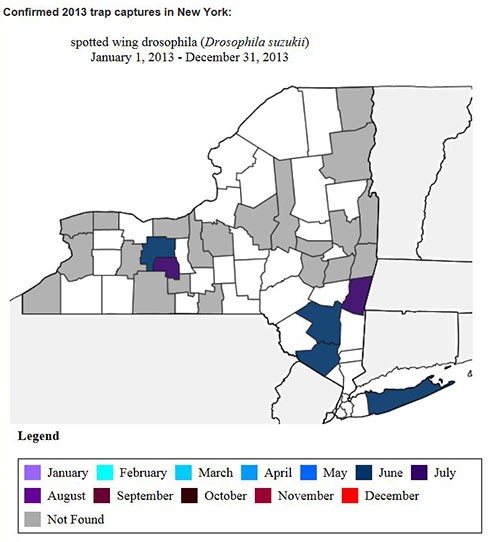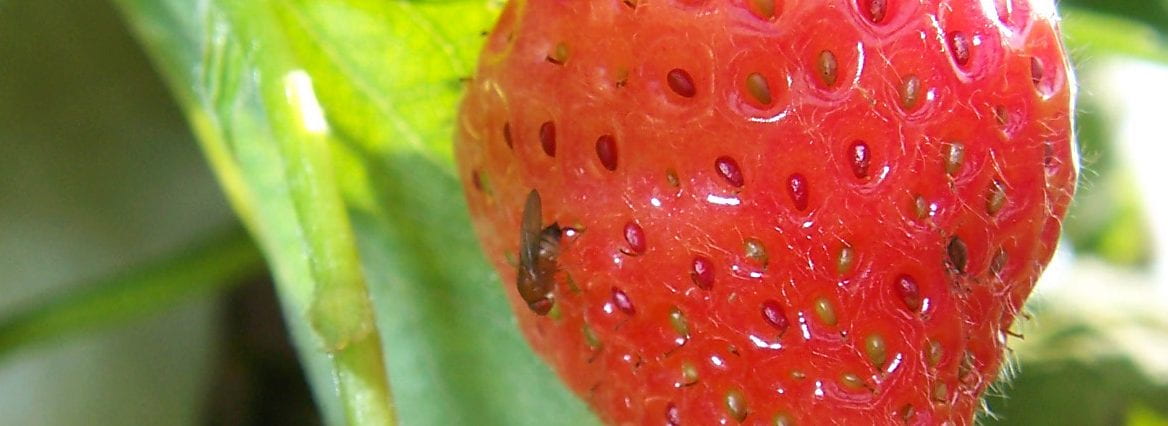SWD has been caught in a trap set in woods adjacent to a blueberry plantation in eastern Schuyler County by Greg Loeb's lab, Dept of Entomology, Cornell University. One male and one female were caught during the week preceding July 11; four males and four females were caught during the week preceding July 17. The time for concern about this difficult-to-control invasive insect is upon us. Carefully planned strategies for management of SWD should be developed, especially for late summer and fall fruit crops. (As of July 11, accumulated GDD 1247, day length 15:01)
Month: July 2013
Wayne County – first report
A single spotted wing drosophila male was caught in a trap collected on July 22 in day neutral strawberries in Wayne County by Juliet Carroll, NYS IPM Program, Cornell Cooperative Extension. Berry crops at risk for infestation include day neutral strawberries, blackberries, raspberries, and blueberries. Berry growers in the area should consider putting a management program into place. In addition, a single male SWD was caught in a trap set in sweet cherry at the same location. Sweet cherry harvest is winding down and fruit destined for farm market shelves will benefit from cold temperature storage or display cases. (Accumulated GDD 1374, day length 14:48)

Upswing in Orange & Ulster
Mike Fargione, Eastern NY Horticulture Program, Cornell Cooperative Extension, reports they are seeing increased captures of SWD in Orange and Ulster counties. Favored host plants for SWD include blackberry, raspberry and blueberry in commercial plantings and gardens, as well as wild brambles such as black cap raspberry and red raspberry. These plants will provide a significant resource for SWD population increase. Consider management tactics for home gardens and commercial fruit plantings.
Oviposition in blackberry
Faruque Zaman and Dan Gilrein, entomologists with Suffolk County Cornell Cooperative Extension at the Long Island Horticultural Research and Extension Center, just finished checking fruit collected July 18 from commercial plantings. Heavy oviposition was found in blackberries where over 50% of the fruit had 1 to 10 SWD eggs. No larvae were found in these samples, indicating the eggs were lain recently. Raspberries and blueberries next to the blackberry field had <1.0% fruit with SWD egg laying. Eggs are inserted into the fruit leaving only the tiny filaments (the eggs' breathing tubes) visible on the outside of fruit. Blackberries are known to be highly susceptible to SWD and these findings underline this.

Upswing in Ontario County
Greg Loeb's lab, Entomology, Cornell University, has seen an increase in SWD adult males and females in traps in Ontario County that were collected July 16. In a raspberry planting, 4 traps caught a total of 1 male and 4 female SWD. In woods next to a strawberry planting, 3 traps caught a total of 3 male and 6 female SWD. In a blueberry planting, 3 traps caught a total of 3 female SWD. Overall, this is a likely trend toward our upswing to peak problems in August in western NY. We (Loeb, Agnello, and Carroll) have not caught SWD in traps set in the Lake Ontario region, yet. Stay tuned.
Raspberries at risk
Greg Loeb's lab, Dept of Entomology, NY State Agricultural Experiment Station, Cornell University, has reared SWD from raspberry fruit that were collected on July 5 in Ontario County.
Laura McDermott, Eastern NY Horticulture Program, Cornell Cooperative Extension, reports finding larvae in raspberry fruit collected July 15 in Rensselaer and Albany Counties, NY. Fruit were collected randomly and the sample included a small amount of overripe fruit. Although the larvae may be SWD, it is not possible to distinguish SWD larvae from other fruit flies.
Infested red raspberry fruit may leave a red juice stain on the berry receptacle when the fruit is picked. Fruit with small indents or bruises where the berry surface appears to have flattened or deflated may be damaged. A salt floatation method may be used for monitoring SWD infestation levels as the season progresses. Immerse fruit in a solution of 1 Tbsp. (14.8 cc) table salt per 1 cup (236.6 ml) water, wait one hour and examine for larvae that float to the surface.
Dutchess County – first report
One male SWD was caught on July 1 in Dutchess County, NY by Peter Jentsch's program, Hudson Valley Lab, Cornell University, as reported by Mike Fargione, E NY Hort Program, Cornell Cooperative Extension. The trap was set in a cherry orchard. (Accumulated GDD 990, day length 15:05)

SWD in PA
As of July 15, spotted wing drosophila females have been found in summer red raspberry plantations in several locations in PA and a few females were found in traps in blueberries in Adams County. Read the SWD Update from Kathleen Demchak, Senior Extension Associate, and David Biddinger, Tree Fruit Research Entomologist, Pennsylvania State University.
SWD management alert!
The SWD trap network in Long Island and the Hudson Valley region of New York is in sustained trap catch. Growers of susceptible, soft-skinned fruit, especially raspberry, blackberry, and blueberry should take this threat seriously. A management strategy that includes protection of the crop with insecticides should be considered. SWD females can lay eggs directly into ripening fruit.

SWD workshop/webinar
The Hudson Valley Lab will be hosting a workshop and webinar on SWD, 1:30-3:00 PM, Tuesday, July 16, 2013. The Lab is located at 3357 Route 9W, Highland, NY. Commercial growers, Extension Educators and Master Gardener Coordinators are invited to attend or join the webinar to learn about this invasive insect, its production implications and control options in organic and conventional fruit plantings. The program is free but please RSVP to Mike Fargione by 7/15/2013 to 845-691-7117 or mjf22@cornell.edu.

